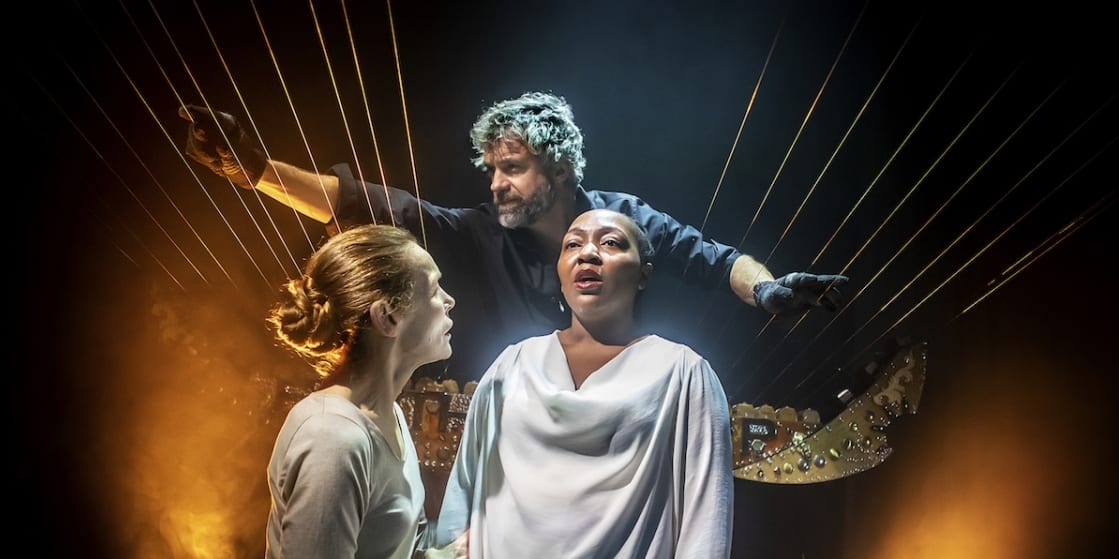After a long period of closure the flexible creative spaces of Hammersmith’s Riverside Studios are open once more, though not yet complete. A wide, welcoming foyer and excellent café are an encouraging start, but the theatre space for this production left a lot to be desired: a steep rake and stage established below the seating meant that many of the (uncomfortable) seats offered a frustratingly restricted view of proceedings. One has to hope this space is reserved for cinematic showings rather than stage works, once the full complex opens.
What works on stage and on film is also, in a way, the central question of this new production.
‘Persona’, is a dramatization of one of Ingmar Bergman’s most enigmatic films, one that continues to fascinate and puzzle critics and analysts to this day. Filmed in black and white and released in 1966 the film was a two-hander between Elisabet, a famous stage actress who has experienced a psychological breakdown and lapsed into silence and a nurse, Sister Alma, who is her designated carer. The action was located mostly at a summer cottage on the island off the Swedish coast, involving evocative landscapes and mysterious monologues which appear at times to merge the two personalities of the characters, a point symbolised by the famous still-photo that merges the profiles of the two actors concerned, Liv Ullmann and Bibi Andersson, two of Bergman’s regular collaborators.
In this adaptation Paul Schoolman has added a framing narration and speaks all of the directions and notes that Bergman had in his shooting script. Otherwise the text remains unchanged. Video footage of the sea is projected onto the backdrop to suggest the location of Faro, and furniture and props are arranged in a broadly realistic fashion, at least from what I could see.
The rewards of this performance lie in the portrayal of Sister Alma by Alice Krige, whose cool mask of professionalism soon fractures into garrulous and fragile confessional mode when faced by the determined silence of her patient. The tables are turned by implacable self-distancing on the part of Nobuhle Mngcwengi’s Elisabet. In two famous scenes – the remembered orgy on the beach, and the reading of the letter – Krige reveals her character’s own tenuous grasp on sanity and reality, thereby raising all sorts of questions over the role of ‘personas’ or masks in our ordinary human interactions.
On the other hand, there are periods of torpor when the pace flags and the visual interest wanes. Scepticism creeps in as to the added value of a staged adaptation. The reading of the stage directions and notes slows down the action and breaks concentration, however much the clues provided by Bergman here are of interest to the scholar and critic. When you need a video as backdrop doesn’t that beg the question of whether the whole thing would be more atmospherically done on celluloid? And, crucially, in a film that is regarded as a landmark in the handling of close-up shots, you have to wonder how much is lost when the audience cannot scrutinise the detail of facial expression and body-language up close….
Even within the terms of the production there is more that could be done. Mngcwengi does little off the speech and leaves all the work to Krige in creating the tensions between the two actors that are at the heart of the film. Schoolman’s introduction of his character as a hospital patient mirroring Bergman’s ill-health at the time of the film’s making, is a distraction too. This is a difficult and enigmatic film anyway, and it needs simplification and elucidation, not further complication.
In one respect this production is, however, quite unique. Accompanying it in a lulling hypnotic underscore is the vast earth harp of William Close. The resonating chamber of the instrument rests on stage and its strings fan out above the audience secured on the ceiling of the studio. The evocative compression waves teased out of the instrument evoke both the sound of an organ in a darkened cathedral and the mesmeric intensity of Indian ragas. Both soothing and disturbing, it definitely enhances the experience of the play and is worth the price of admission in its own right.
In sum, there is some very fine acting here and a remarkable soundscape, but the case for placing this film on stage is not ultimately convincing. For those intrigued by the original film the informative background panels in the corridor outside do a rather better job in teasing out Bergman’s meaning and intentions.

